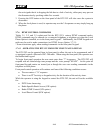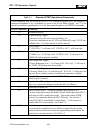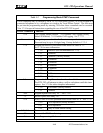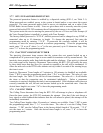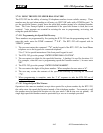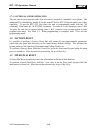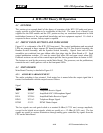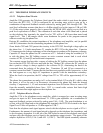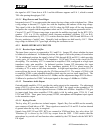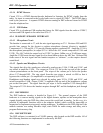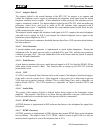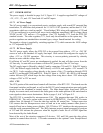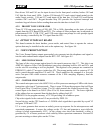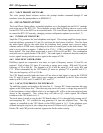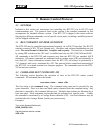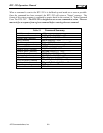
RTU-292 Operations Manual
the signal at A/D 2 from that at A/D 1 and the difference appears on D/A 1, which is named
TEL after passing through gate U8C.
4.3.2.3 Ring Detector and Tone Ringer
Integrated circuit U7 is an optocoupler that senses the ring voltage on the telephone line. When
a ring voltage is detected, U7-5 goes low with the frequency and cadence of the ring voltage.
This signal is fed to the DSP module on J14-28, where the DSP strips off the ring frequency
and passes the a signal with the ring cadence alone on J14-7 to the ring tone generator circuit.
Circuits U31 and U32 form a tone ringer to provide the audible ring signal for the RTU-292’s
speaker. U32 is a 10 Hz oscillator which frequency-modulates oscillator U31 via R41.
Because of the modulation by U32, U31 switches between about 1000 Hz and 800 Hz at a 10
Hz rate, producing a “warble” tone. Normally, both oscillators are held reset by J14-7. When
ring voltage is detected, J14-7 goes high, allowing the oscillators to run.
4.3.3 RADIO INTERFACE CIRCUITS
4.3.3.1 Receiver Input Amplifier
The input from a receiver is connected to P1-1 and P1-6. Jumper JP1 selects whether the input
is balanced or unbalanced. In Balanced position, the signal is fed to the primary of transformer
T2. In unbalanced position, the signal is fed to U20A through R110 and R111, which provides
a unity gain, AC-coupled input of 47k impedance. R110 and C59 are in the circuit for RF
decoupling. The secondary of T2 is connected to amplifier U20A, configured as a high input
impedance unity gain amplifier. In balanced position, Jumper JP2 determines the input
impedance of the receiver input. In low impedance position, R112 is placed across the
secondary of T2 to make a 600 ohm termination. In high input impedance position, R112 is
removed from the circuit, leaving only the 47k Ohm resistor R113. The output of U20A is fed
to amplifier U20B, a gain adjustable amplifier which sets the receiver input signal level. The
output of U20B is nominally at the level of -10dBm, and the adjustment range of R116 allows -
10 dBm to be produced at U20B-7 with input signals in the range of -40dBm to +10dBm.
4.3.3.2 Transmitter Audio Output
Gain-adjustable amplifier U21A provides the audio output to the transmitter. The adjustment
range of R133 is set so that with 0 dBm audio at U21B-7, the signal on the secondary of T3
(loaded with 600 Ohms) can be adjusted between +10dBm and -40 dBm. Amplifier U21A gets
its input signal from mixer amplifier U21B, which is fed by analog gates U22A, B, C and
U23A and U23B. These gates route prompt, DTMF, microphone and telephone input signals
to the transmitter output.
4.3.3.3 Keying Circuits
The key relay, K2, provides two isolated outputs. Signals /Key Out and KB are the normally
open contacts of both halves of K2. These signals are routed to P1-4 and P1-9 and are shorted
to ground when the key relay is energized.
Signals from /KEY IN and CPU KEY are summed in U24B and drive key relay driver Q4.
Transistor Q5 is driven by the VOX key output from the DSP. U24A ensures that the
microphone key switch will not function unless enabled by the CPU board with the MIC KEY
EN signal.
JPS Communications, Inc.
4-21



